
table of contents
- Bird egg diversity
- White eggs
- White eggs with spots or spots
- Green bird eggs
- Blue eggs
- Brown bird eggs
- Red, gray and yellow eggs
- frequently asked Questions
Every now and then you come across bird nests, eggs or eggshells while hiking or gardening. Which bird laid the eggs? We have compiled characteristics of the bird eggs of native species.
In a nutshell
- Bird nests with eggs rarely require human help
- Depending on the bird species, the birds leave the nest for a short time
- Eggs can sometimes be laid for several days
- Coloring of the eggs adapted to the breeding sites
Bird egg diversity
Bird eggs can be small or large, light or dark, solid or speckled, rough or smooth, matt or glossy. We have put together the eggs of domestic birds for you, separated by color, with the most important characteristics.
Note: The Federal Nature Conservation Act prohibits the taking of bird eggs from nature.
White eggs
Great spotted woodpecker (Dendrocopos major)
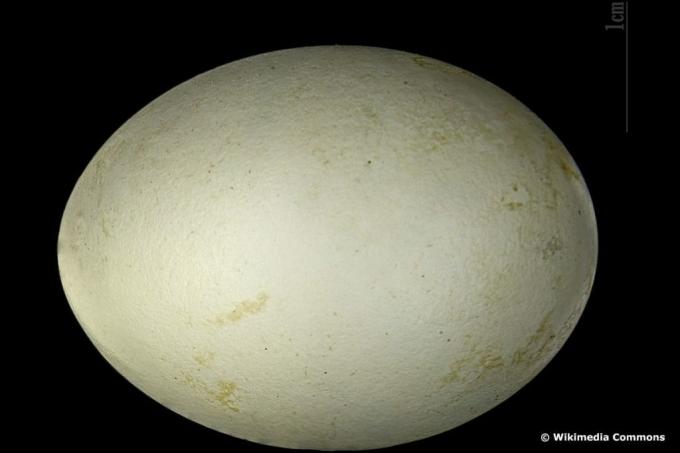
- Habitat: forest areas, gardens, settlements
- Breeding season: April to August, one year brood
- Incubation period: 11 to 12 days
- Storage location: breeding caves in rotten tree trunks
- Clutch size: 4 to 7 eggs
- Egg size: 20 x 29 millimeters
Kingfisher (Alcedo atthis)

- Habitat: rivers, lakes
- Breeding season: March to September, two to four annual broods
- Incubation period: 17 to 21 days
- Storage location: on steep banks of water in nest tubes
- Clutch size: 6 to 7 eggs
- Egg size: 22 x 16 millimeters
Green Woodpecker (Picus viridis)

- Habitat: forest edges, gardens
- Breeding season: April to August, one year brood
- Incubation period: 14 to 15 days
- Storage location: tree hollows, nesting boxes
- Clutch size: 5 to 8 eggs
- Egg size: 28 x 33 millimeters
- Feature: white, smooth and shiny
Goshawk (Accipiter gentilis)

- Habitat: coniferous forest
- Breeding season: March to July, one year brood
- Incubation period: 35 to 40 days
- Storage location: in the treetops
- Clutch size: 2 to 5 eggs
- Egg size: 55 x 42 millimeters
Great Crested Grebe (Podiceps cristatus)

- Habitat: coastal areas, lagoon waters
- Breeding season: March to October, one or two annual broods
- Incubation period: 25 to 29 days
- Filing location: in the water, in the bank vegetation
- Clutch size: 2 to 6 eggs
- Egg size: 53 x 35 millimeters
Mandarin duck (Aix galericulata)

- Habitat: bodies of water with dense bank vegetation and trees
- Breeding season: April to May, one year brood
- Incubation period: 28 to 30 days
- Storage location: tree hollows
- Clutch size: 9 to 12 eggs
- Egg size: 49 x 39 millimeters
Common Swift (Apus apus)
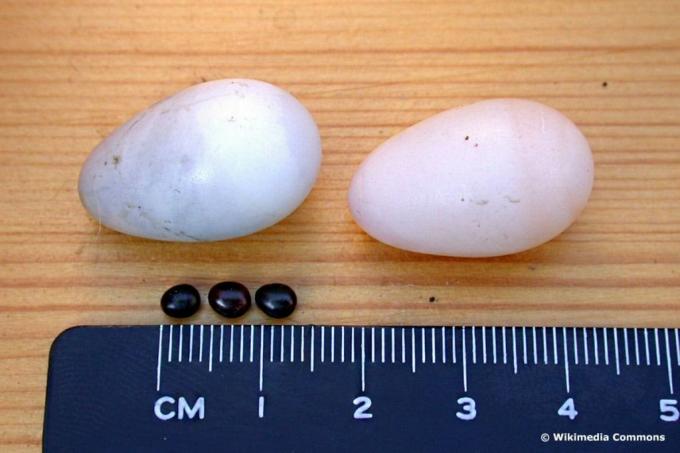
- Habitat: rock faces, settlements
- Breeding season: May to September, one year brood
- Incubation period: 20 to 21 days
- Storage location: in rock caves, on buildings
- Clutch size: 2 to 3 eggs
- Egg size: 25 x 16 millimeters
House martin (Delichon urbicum)

- Habitat: settlements
- Breeding season: May to September, one to two annual broods
- Incubation period: 17 to 20 days
- Storage location: on the exterior walls of buildings
- Clutch size: 3 to 5 eggs
- Egg size: 19 x 13 millimeters
City pigeon (Columba livia domestica)
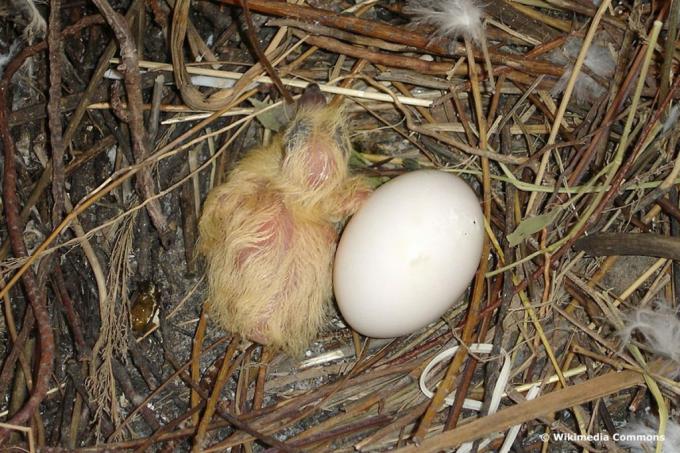
- Habitat: settlements
- Breeding season: March to August, two to four annual broods
- Incubation period: 16 to 18 days
- Storage location: in buildings
- Clutch size: 2 to 3 eggs
- Egg size: 26 x 30 millimeters
- Feature: white, glossy
White stork (Ciconia ciconia)

- Habitat: fields and meadows, wetlands
- Breeding season: March to September
- Incubation period: 32 to 34 days
- Storage location: on roofs, towers and trees
- Clutch size: 3 to 5 eggs
- Egg size: 77 x 52 millimeters
White eggs with spots or spots
Blue tit (Cyanistes caeruleus)
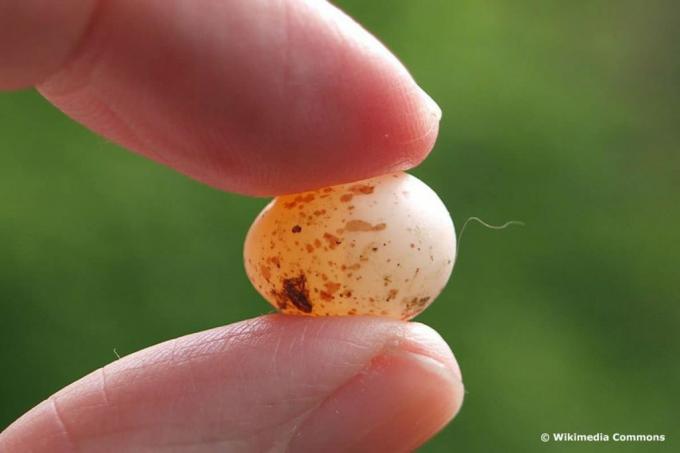
- Habitat: forests, gardens, settlements
- Breeding season: March to August, one or two annual broods
- Incubation period: 13 to 15 days
- Storage location: in tree hollows
- Clutch size: 6 to 14 eggs
- Egg size: 16 x 12 millimeters
- Characteristic: white with red-brown spots
Skylark (Alauda arvensis)

- Habitat: meadows, fields, sand dunes
- Breeding season: April to August, two annual broods
- Incubation period: 11 to 14 days
- Storage location: on the floor, in troughs
- Clutch size: 3 to 5 eggs
- Egg size: 24 x 17 millimeters
- Characteristic: white with brown spots
Nuthatch (Sitta europaea)
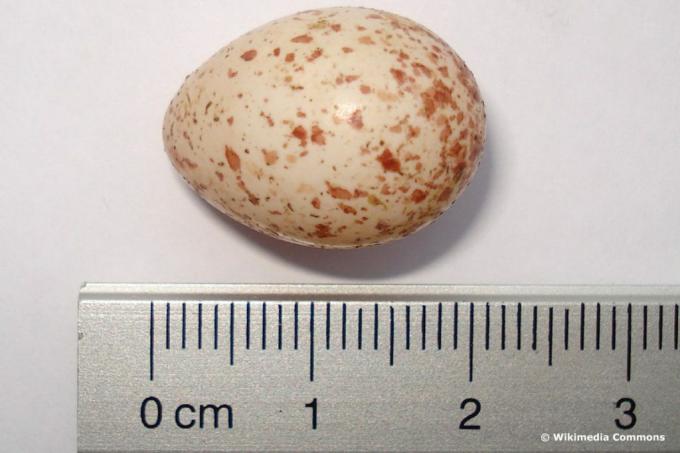
- Habitat: forests, gardens, settlements
- Breeding season: March to June, one year brood
- Incubation period: 15 to 18 days
- Storage location: in tree hollows
- Clutch size: 5 to 9 eggs
- Egg size: 19 x 15 millimeters
- Characteristic: white with brown spots
Great tit (Parus major)

- Habitat: forests, gardens, settlements
- Breeding season: March to August, one or two annual broods
- Incubation period: 13 to 15 days
- Storage location: in tree hollows, nesting boxes
- Clutch size: 6 to 12 eggs
- Egg size: 18 x 13 millimeters
- Characteristic: white with red-brown spots
Common buzzard (Buteo buteo)

- Habitat: fields, forests, arable land
- Breeding season: March to August, one year brood
- Incubation period: 33 to 35 days
- Filing location: in trees
- Clutch size: 2 to 3 eggs
- Egg size: 60 x 45 millimeters
- Characteristic: white with brown spots
Red kite (Milvus milvus)

- Habitat: fields, meadows, forest edges
- Breeding season: April to August, one year brood
- Incubation period: 29 to 30 days
- Storage location: in trees, on rocky outcrops
- Clutch size: 2 to 3 eggs
- Egg size: 57 x 45 millimeters
- Characteristic: white with brown spots
Tailed tit (Aegithalos caudatus)
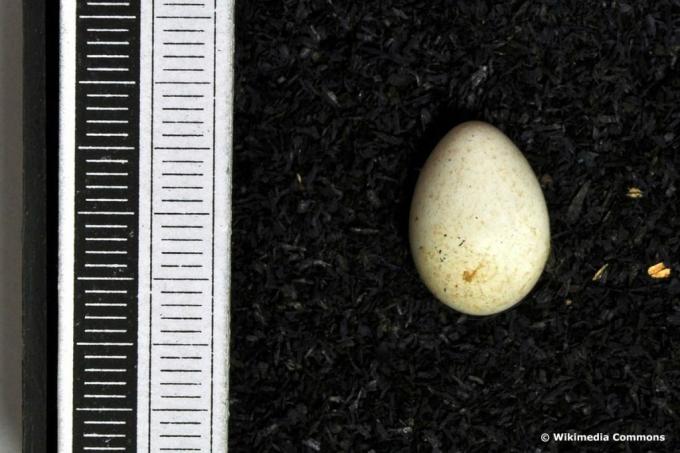
- Habitat: forest edges, parks, gardens
- Breeding season: March to June, one year brood
- Incubation period: 13 to 14 days
- Filing location: in trees, hedges and bushes
- Clutch size: 8 to 12 eggs
- Egg size: 14 x 11 millimeters
- Characteristic: white with red dots
Wren (Troglodytes troglodytes)

- Habitat: Forest edges with a lot of undergrowth
- Breeding season: April to August, two annual broods
- Incubation period: 15 to 16 days
- Storage location: on the ground in dense forest vegetation
- Clutch size: 5 to 7 eggs
- Egg size: 17 x 12 millimeters
- Characteristic: white with brown spots
Green bird eggs
Magpie (Pica Pica)

- Habitat: forests, gardens, settlements
- Breeding season: March to August, one year brood
- Incubation period: 17 to 18 days
- Deposition location: in hedges and deciduous trees. Clutch size: 5 to 7 eggs
- Egg size: 33 x 23 millimeters
- Characteristic: green with dark brown spots
Common redstart (Phoenicurus phoenicurus)
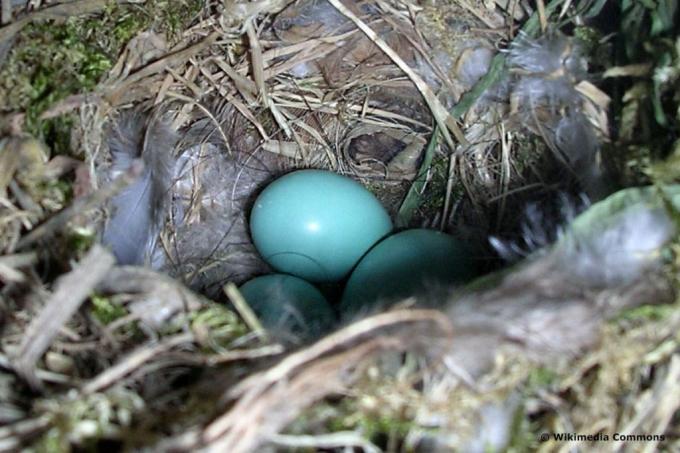
- Habitat: gardens, parks, forests, settlements
- Breeding season: April to August, one year brood
- Incubation period: 12 to 14 days
- Storage location: on buildings, in nesting boxes
- Clutch size: 5 to 7 eggs
- Egg size: 19 x 14 millimeters
- Characteristic: greenish blue
Gray heron (ardea cinerea)
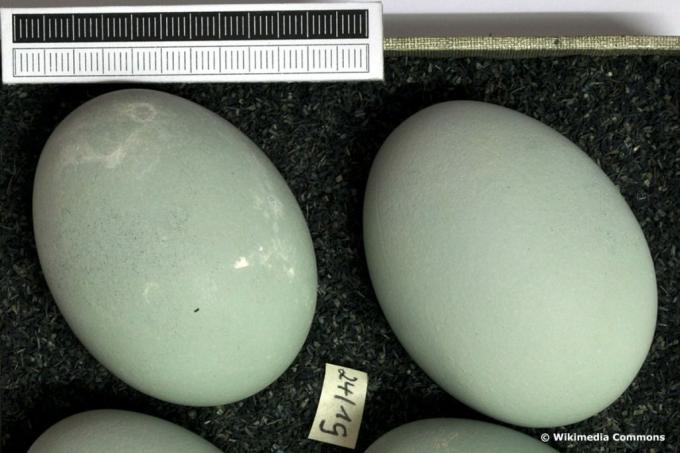
- Habitat: lakes, rivers, wetlands
- Breeding season: February to August, one year brood
- Incubation period: 25 to 28 days
- Storage location: in the treetops
- Clutch size: 3 to 5 eggs
- Egg size: 60 x 43 millimeters
- Feature: green-blue, matt surface
Mute Swan (Cygnus olor)
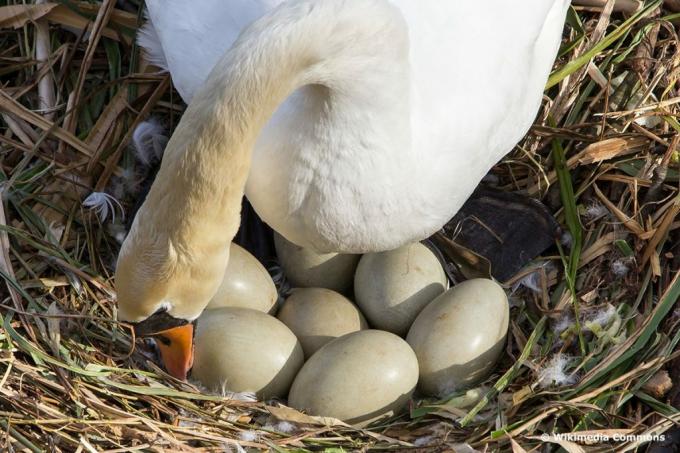
- Habitat: ponds, pools, rivers, lakes
- Breeding season: April to October, one year brood
- Incubation period: 33 to 38 days
- Storage location: on the water in the bank vegetation
- Clutch size: 5 to 8 eggs
- Egg size: 98 x 62 centimeters
- Characteristic: greenish gray
Herring Gull (Larus argentatus)

- Habitat: coastal areas, dunes, fields, wetlands
- Breeding season: April to August, one year brood
- Incubation period: 27 to 30 days
- Storage location: on the ground, on ledges, in buildings
- Clutch size: 2 to 3 eggs
- Egg size: 71 x 49 millimeters
- Feature: olive green
Pintail (anas acuta)

- Habitat: coastal waters and lakes. Breeding season: April to August, an annual brood
- Incubation period: 22 to 25 days
- Storage location: on the ground, in dense bank vegetation
- Clutch size: 7 to 10 eggs
- Egg size: 54 x 37 millimeters
- Characteristic: greenish yellow
Star (Sturnus vulgaris)
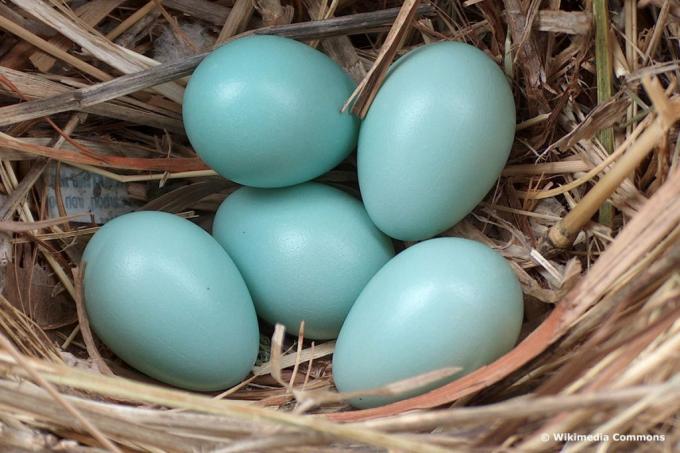
- Habitat: fields, gardens, forests
- Breeding season: March to July, one to two annual broods
- Incubation period: 12 to 13 days
- Storage location: in tree hollows, in nesting boxes
- Clutch size: 4 to 7 eggs
- Egg size: 30 x 21 millimeters
- Characteristic: greenish blue
Mallard (Anas platyrhynchos)
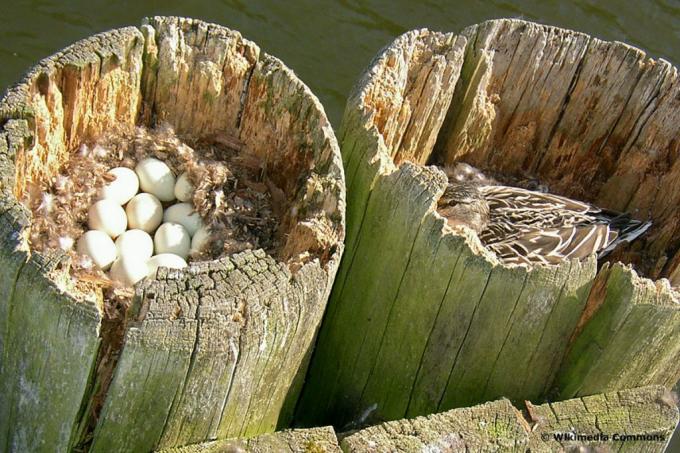
- Habitat: on flowing waters
- Breeding season: late February to September, one year brood
- Incubation period: 28 to 29 days
- Storage location: in a hollow in the ground, a little away from the bank
- Clutch size: 10 to 12 eggs
- Egg size: 57x 41 centimeters
- Characteristic: greenish gray
Blue eggs
Blackbird (Turdus merula)

- Habitat: forests, gardens, settlements
- Breeding season: February to August, two to four annual broods
- Incubation period: 13 to 14 days
- Storage location: close to the ground in hedges and bushes
- Clutch size: 4 to 5 eggs
- Egg size: 29 x 21 millimeters
- Characteristic: blue with brown pattern, slightly shiny
Crossbill (Loxia curvirostra)

- Habitat: coniferous and mixed forests
- Breeding season: January to March, one to two annual broods
- Incubation period: 14 to 16 days
- Filing location: in conifers
- Clutch size: 3 to 5 eggs
- Egg size: 22 x 16 millimeters
- Characteristic: bluish with brown spots
Bullfinch (Pyrrhula pyrrhula)

- Habitat: forests, parks, gardens
- Breeding season: April to July, two annual broods
- Incubation period: 13 to 14 days
- Filing location: in trees and bushes
- Clutch size: 4 to 6 eggs
- Egg size: 18 x 13 millimeters
- Feature: light blue with black dots
Greenfinch (Carduelis chloris)
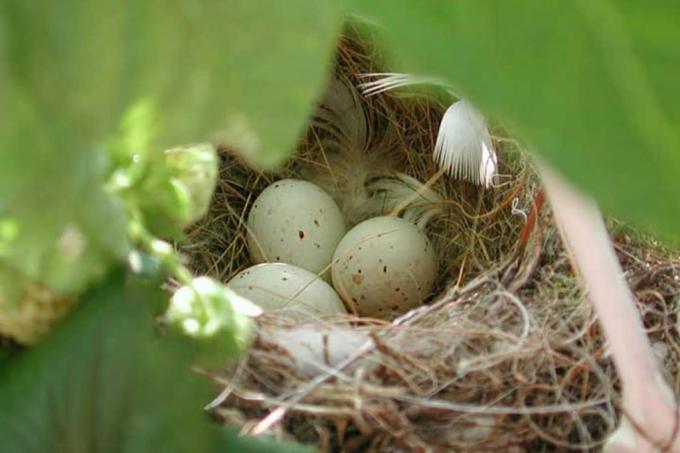
- Habitat: forest, fields, gardens
- Breeding season: March to August, one or two annual broods
- Incubation period: 12 to 14 days
- Storage location: in hedges, bushes, trees
- Clutch size: 3 to 7 eggs
- Egg size: 20 x 14 millimeters
- Characteristic: light blue with brown spots
House Sparrow (Passer domesticus)

- Habitat: gardens, parks, settlements
- Breeding season: March to September, two to four annual broods
- Incubation period: 12 to 14 days
- Storage location: on buildings, in nesting boxes, in trees
- Clutch size: 4 to 6 eggs
- Egg size: 22 x 16 millimeters
- Characteristic: light blue with brown spots
Common raven (Corvus corax)
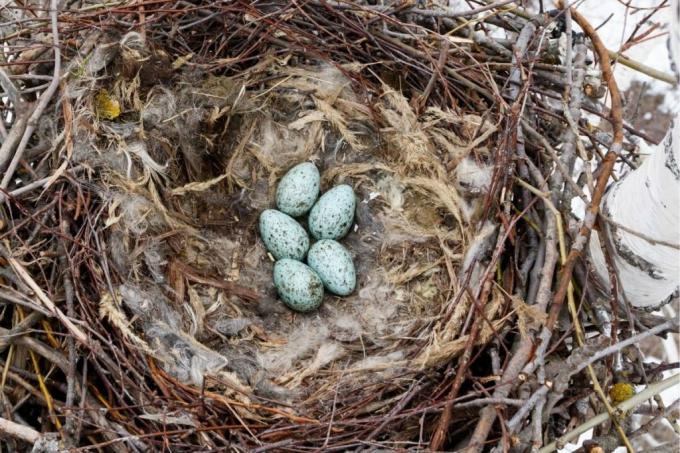
- Habitat: forest, mountains
- Breeding season: February to August, one year brood
- Incubation period: 20 to 21 days
- Storage location: in trees, on rocky slopes
- Clutch size: 3 to 6 eggs
- Egg size: 49 x 33 millimeters
- Characteristic: blue or green with dark spots
Great cormorant (Phalacrocorax carbo)

- Habitat: on large lakes and rivers
- Breeding season: March to August, one year brood
- Incubation period: 28 to 30 days
- Storage location: on trees, in rocky outcrops
- Clutch size: 3 to 4 eggs
- Egg size: 59 to 41 millimeters
- Feature: light blue
Goldfinch (Carduelis carduelis)

- Habitat: forests, arable land
- Breeding season: April to September, two annual broods
- Incubation period: 12 to 14 days
- Storage location: in forks of branches
- Clutch size: 4 to 6 eggs
- Egg size: 17 x 13 millimeters
- Characteristic: bluish with red-brown spots
Brown bird eggs
Lapwing (Vanellus vanellus)

- Habitat: wet meadows, pastures
- Breeding season: March to August, one year brood
- Incubation period: 26 to 27 days
- Storage location: on the ground in meadows and fields
- Clutch size: 3 to 4 eggs
- Egg size: 46 x 32 millimeters
- Characteristic: light brown with black spots
Crane (grus grus)
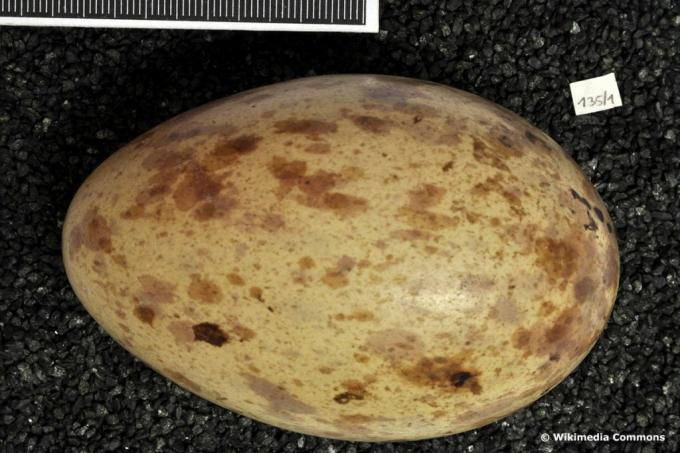
- Habitat: moors, swamps, fields, bodies of water
- Breeding season: March to September, one year brood
- Incubation period: 28 to 30 days
- Storage location: on the ground
- Clutch size: 1 to 2 eggs
- Egg size: 98 x 62 millimeters
- Characteristic: olive-brown or red-brown with brown spots
Black-headed gull (Chroicocephalus ridibundus)
- Habitat: coastal areas, meadows, pastures, wetlands
- Breeding season: April to July, one year brood
- Incubation period: 22 to 24 days
- Storage location: on the ground near the water
- Clutch size: 2 to 3 eggs
- Egg size: 52 x 36 millimeters
- Characteristic: brownish or greenish with dark spots
Note: Nest boxes are a great way to support native birds. Make sure you are at the correct height. To protect the bird's eggs from nest robbers, we recommend placing nest boxes in places where no branches can come off.
Red, gray and yellow eggs
Chaffinch (Fringilla coelebs)
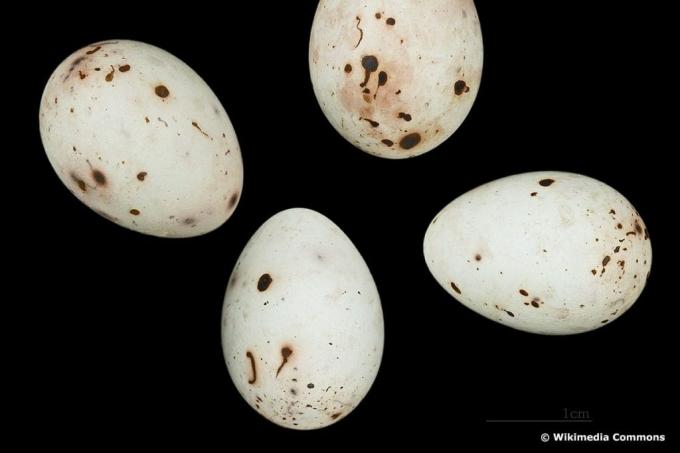
- Habitat: forests, gardens, settlements
- Breeding season: April to August, two annual broods
- Incubation period: 12 to 13 days
- Storage location: in forks of branches
- Clutch size: 4 to 6 eggs
- Egg size: 19 x 15 millimeters
- Characteristic: reddish with red-brown spots
Grosbeak (Coccothraustes coccothraustes)
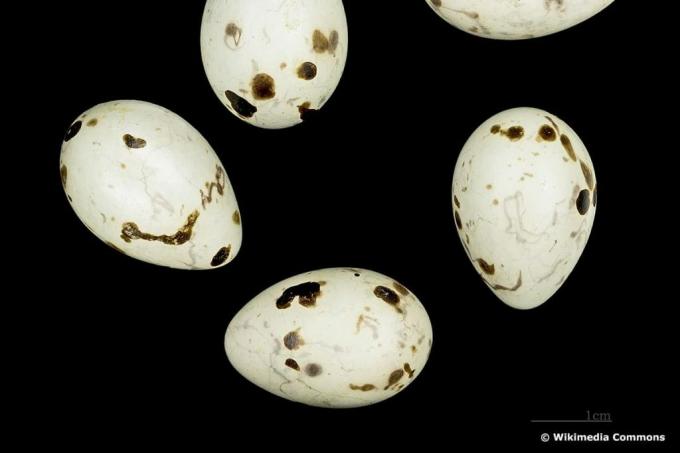
- Habitat: forests, gardens
- Breeding season: April to August, one year brood
- Incubation period: 11 to 12 days
- Storage location: in bushes and hedges
- Clutch size: 4 to 6 eggs
- Egg size: 24 x 18 millimeters
- Characteristic: gray with dark brown spots
European robin (Erithacus rubecula)

- Habitat: forest, gardens, settlements
- Breeding season: April to August, two annual broods
- Incubation period: 13 to 14 days
- Storage location: in the undergrowth, in the grass, in holes in the ground
- Clutch size: 4 to 6 eggs
- Egg size: 20 x 15 millimeters
- Characteristic: yellowish with brown spots
Note: Note that to protect the birds' eggs, the hedge cut from 1. March to 30th September is prohibited. Only one maintenance cut is allowed during this time.
Special case: cuckoo (Cuculus canorus)

- Habitat: light forest areas, near water
- Breeding season: April to September
- Incubation period: 12 to 13 days
- Filing location: in the nests of other birds
- Clutch size: 10 to 25 eggs
- Egg size: 21 x 17 millimeters
- Characteristic: color matched to the host animal's eggs
frequently asked Questions
If an egg is fertilized or not, experts can tell by X-raying it with a strong light source. Unfertilized eggs are clear. In contrast, fertilized eggs are opaque. The reason for this are blood vessels that form shortly after fertilization to supply the embryo with nutrients.
Shades of color, patterns or speckles serve as camouflage and protection from predators. The eggs of many bird species can therefore hardly be distinguished from their surroundings.
Most eggs are oval in shape. This prevents it from rolling away quickly. Owls usually lay round eggs. They breed in a tree hole where there is no danger of rolling away.



